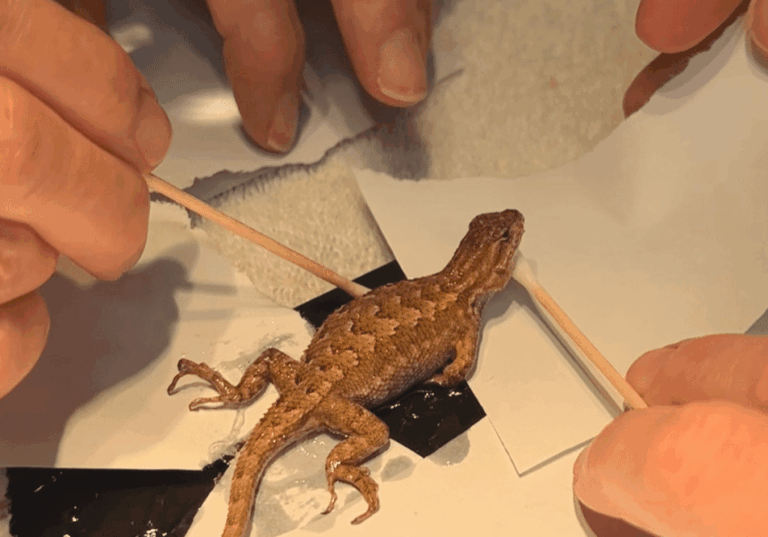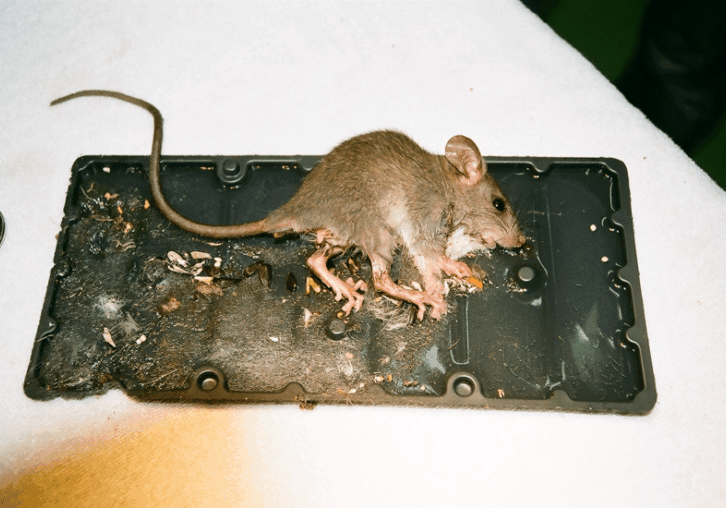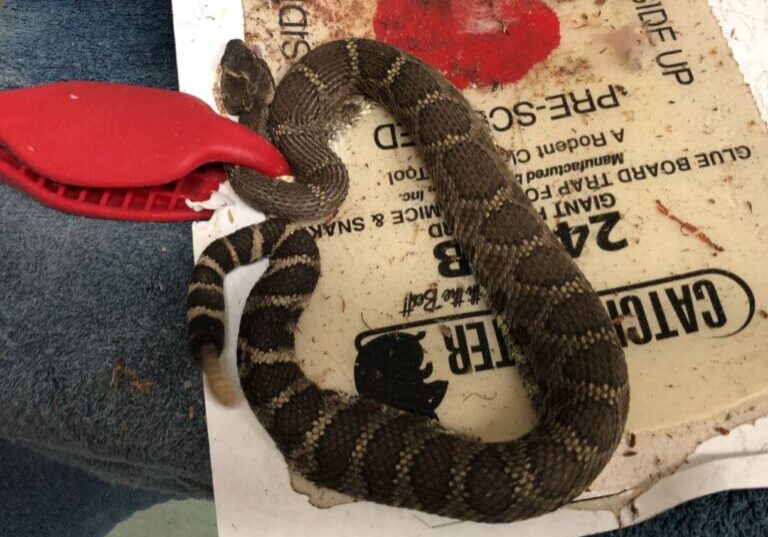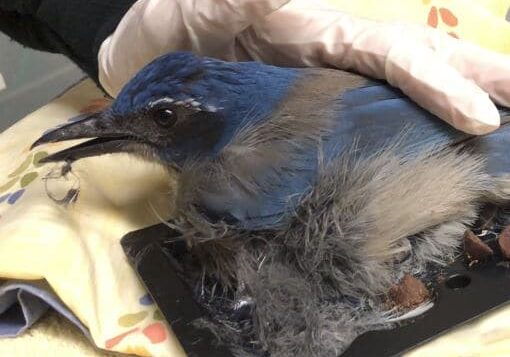What Is a Glue Trap
A glue trap is a small, flat board made of cardboard or plastic that is coated with an extremely sticky adhesive. Advertising for these products implies that they are clean, non-toxic and effective. Many products feature cute cartoons of stuck rodents. The manufacturers imply that all you have to do is uncover the sticky plate, put it where mice and rats have been seen and somehow the problem is solved. People don't think about what happens next.
What happens next is horrific.
The glue trap doesn’t instantly kill the animal — the glue is not toxic. Instead, the animal stays stuck, dying over the course of several days from starvation, dehydration and suffocation.
WildCare admits a dozen or more animals stuck to glue traps every year, and each one is heartbreaking. Animals stuck to glue traps will rip off their own skin and fur trying to escape. They will even chew off their own limbs in a desperate attempt to get away. They inflict terrible injuries on themselves, even fracturing limbs, trying to get free. Trapped animals suffer for days as they slowly suffocate and starve.
That was the fate that awaited this scrub jay, except a young boy saw him stuck to the glue trap and tossed in the garbage by someone who must have thought he was dead. The young boy brought the bird on the sticky tray to WildCare, heartbroken at the thought of what had happened to him.
Without exception, every person who has rushed to WildCare’s Wildlife Hospital with an animal stuck in a glue trap that they set has expressed deep regret. Each person says that, had they known how intensely the trapped animal would suffer, no matter how despised that animal may be, they never would have used the product.
Update September 2025:
San Francisco Animal Commission Unanimously Votes to Recommend A Ban on Glue Traps
On Thursday evening, September 11, 2025, the San Francisco Commission of Animal Control and Welfare voted unanimously to pass a recommendation to the San Francisco Board of Supervisors and Mayor Lurie for a citywide ban on the sale and use of glue traps.
WildCare applauds this recommendation and commends the Commission for taking this important first step to ban these cruel and inhumane traps!
Click below to see how you can help make this important ban a reality!
San Francisco residents: Please contact your Supervisor and Mayor Lurie and respectfully express your support for a ban on the sale and use of glue and sticky traps in San Francisco.
The San Francisco Commission of Animal Welfare and Control makes the recommendation, but the Board of Supervisors must move forward with legislation to make the ban a reality. Expressing your support by phone and email will alert Supervisors and the Mayor that banning glue traps is something their constituents care about.
Sample script:
As a supporter of WildCare and a resident of District __ in San Francisco, I would like to express my support for a ban on the sale and use of glue and sticky traps in the City.
Such a ban would prevent any more animals from suffering a horrible death from hunger, thirst, exposure and trauma from being immobilized by a glue trap. Glue traps are one of the most heart-wrenching - and preventable - reasons for patients to be admitted to WildCare's Wildlife Hospital. The organization, and other wildlife care centers frequently admit glue-trapped songbirds, lizards, and other animals from San Francisco, Marin, and throughout the Bay Area. The suffering caused by these devices cannot be overstated.
Such cruelty is reason enough to ban glue traps. But in addition to being inhumane, glue traps are not effective at reducing rodent populations. A rodent problem can only be truly solved by removing what is attracting the rats or mice -- usually food. Although the glue trap may capture a few rodents, only sealing entrance holes and removing attractants will permanently solve a nuisance rodent problem.
Glue traps also present a health hazard that belies their claims of being safe and non-toxic. Trapped animals remain alive for extended periods, during which they can excrete bodily fluids, attract insects, and increase the likelihood of disease transmission. Far from providing a safe or sanitary solution, glue traps exacerbate the concerns they are deceptively marketed to address.
If the San Francisco Board of Supervisors were to enact a ban on the sale and use of glue traps, the City will not be alone. Hundreds of companies and entities as well as countries including England, Iceland, Ireland, New Zealand, Scotland, and Wales; two Australian states and one territory; and more than 30 states and union territories in India have all banned glue traps. If San Francisco bans glue traps, it will become the third and largest American city to do so after West Hollywood and Ojai, California.
If you're not a resident of San Francisco, but you still want to help WildCare support a ban on glue and sticky traps, please add your name and information below!
Help WildCare Support H.R. 7018, the Glue Trap Prohibition Act (Rep. Ted Lieu (D-Ca.-36))
WildCare asks you to support the Glue Trap Prohibition Act (HR7018), which would ban the use, sale, and distribution of glue traps, which kill, injure, and permanently disable countless small animals every year. Click here to sign the petition in support of the bill!
Glue traps are indiscriminate killing devices that are designed to ensnare any small animal who wanders across their surface. Trapped in the glue and terrified, animals can take days to die of starvation, dehydration, and exposure. In some cases, their noses, mouths, or beaks get stuck in the glue, causing them to suffocate to death over the course of hours.
Fighting for their lives, animals stuck to glue traps panic and struggle, and their frantic attempts to flee only lead to them becoming even more ensnared. Often, the glue tears off patches of fur, feathers, or skin, and the animal's frantic attempts to get away can break bones. Some animals even chew off their own limbs in a desperate effort to escape.
WildCare and our allies are asking all organizations and individuals dedicated to helping animals to support the Glue Trap Prohibition Act, which would outlaw these dangerous and cruel devices and help protect wildlife. In our Wildlife Hospital, we admit a dozen or more animals trapped by glue traps every year, and every one is heartbreaking. Many cannot be saved.
WildCare Patients Trapped by Glue Traps
WILDCARE PRESENTATION AGAINST THE USE OF GLUE TRAPS
WildCare's Alison Hermance gave a presentation about the horrors of glue traps to the San Francisco Animal Commission.
WildCare's goal has always been to stop the use of these incredibly inhumane devices by raising public awareness, and working to get them banned in San Francisco, Marin and ultimately California and beyond.
The video below shows Alison's presentation to the Commission and the discussion afterward about potentially presenting a ban on glue traps to the San Francisco Board of Supervisors.
How to Control Rodents Without Using Glue Traps
It's entirely possible to deal with a nuisance rodent situation WITHOUT resorting to the use of glue traps or poisons!
(Click here for a PDF of this information)
People put out glue traps because they see rodents and want them gone. Rodents inside the home should be evicted and excluded, but remember that rodents outside are part of the natural environment. Traps of any variety should never be placed outside.
The best method of rodent control is prevention. Rodents tend to set up camp in our homes when food and space are made available to them. How can you get rid of them?
Remove potential rodent homes like yard debris, trash, construction waste, etc. Rodents also thrive in groundcover like ivy, so removing ivy from the yard, especially around the house, is a good solution too.
Eliminate food sources. Keep bulk food, seed, and dry pet food in metal cans with secure lids. Pick up fallen fruit. Sweep under birdfeeders and take them inside at night.
Exclude rodents from your home. Seal openings 1/4 inch or larger around the outside of your house with metal, concrete, or Stuf-fit Copper Mesh Wool, which can be found online or at hardware stores. If you would like humane, professional advice on rodent exclusion, contact our Living with Wildlife Hotline at 415-456-7283.
Include natural rodent predators in your solution. A family of five owls can consume up to 3000 rodents in breeding season. Placing a nest box to encourage a family of owls to make your property home can be a great alternative to commercial pest control methods.
Use catch-and-release traps as a safe, sanitary, and humane solution. Catch-and-release traps will allow you to remove rodents from inside your home, but you must prevent their return by sealing entrance and exit holes and removing attractants (see above).
If you exhaust all the above efforts and as a last resort decide that lethal control of rodents is necessary, please use a rat zapper or snap traps (but only for inside use).





